Arm Announces Mobile Armv9 CPU Microarchitectures: Cortex-X2, Cortex-A710 & Cortex-A510
by Andrei Frumusanu on May 25, 2021 9:00 AM EST- Posted in
- SoCs
- CPUs
- Arm
- Smartphones
- Mobile
- Cortex
- ARMv9
- Cortex-X2
- Cortex-A710
- Cortex-A510
A new CI-700 Coherent Interconnect & NI-700 NoC For SoCs
Finally, the last new announcement of the day is a new interconnect and network-on-chip generation. The last time Arm had announced a mobile/client interconnect was back in in 2015 with the CCI-550. The reason for the large gap between IPs, in Arm’s own words, is that ever since Arm’s introduction of the DSU in its CPU complexes, there really hasn’t been any need for a cache coherent interconnect in the market. While that’s eyebrow-raising from a GPU perspective, it makes perfect sense from a CPU perspective, as coherency between CPU cores was the primary driver for such interconnects until then.
With the advent of new more complex computing platforms, such as NPUs, accelerators, and hopeful more use of GPUs in cache-coherent fashions, Arm saw a need gap in its portfolio and decided to update its client-side interconnect IP.
The new CI-700 is a mobile and client optimised variant of Arm’s infrastructure CMN mesh network, implementing important new interoperability with the new IP announced today, such as the new DSU or CPU cores.
The new mesh interconnect scales up from 1 to 8 DSU clusters, and supports up to 8 memory controllers, and also introduces innovations such as a system level cache.
The mesh network topology and building blocks is very similar to what we’ve seen in the CMN infrastructure IP, in that “points” in the mesh are comprised of “cross-points” or “XP”. One differentiation that’s unique to the client mesh implementation is that XPs can have more attached connectivity ports, trading in routing connection paths. The new IP can also be configured as just a sole XP with no real mesh so to speak of, or essentially a 1x1 mesh configuration. This can grow up to a 4x3 mesh in the largest possible configuration.
The mesh supports from 1 to 8 SLC slices, with up to 4MB per slice for a total of 32MB, and snoop filter SRAM with coverage of up to 8MB address space per slice. It’s noted that generally Arm recommends 1.5-2x of coverage of the underlying private cache hierarchies of the mesh clients.
The SLC can server as both a bandwidth amplifier as well as reducing external memory/DRAM transactions, reducing system power reduction.
We see a reiteration of the support for MTE, allowing for this generation of IPs to support the feature across the new CPU IP, the DSU, and the new cache coherent interconnect.
Alongside the new CI-700 coherent interconnect, we’re also seeing a new NI-700 network-on-chip for non-coherent data transfers between a SoC’s various IP blocks. The big new improvements here is the introduction of packetization for data transfers, which leads to a reduction of wires and thus improves area efficiency of the NoC on the SoC.
Overall, the new system IP announced today is very interesting, but the one question that’s one has to ask oneself is exactly who these net interconnects are meant for. Over the last few years, we’ve seen essentially every major mobile vendor roll out their own in-house cache-coherent interconnect IP, such as Samsung’s SCI or MediaTek’s MCSI, and other times we don’t see vendors talk about their in-house interconnects at all (Qualcomm). Due to almost everybody having their own IP, I’m not sure what the likelihood would be that any of the big players would jump back to Arm’s own solutions – if somebody were to adopt it, it would rather be amongst the smaller name vendors and newcomers to the market. From a business and IP portfolio perspective, the new designs make a lot of sense and allows to have the building blocks to create a mostly Arm-only SoC, which is an important item to have on the menu for Arm’s more diverse customer base.


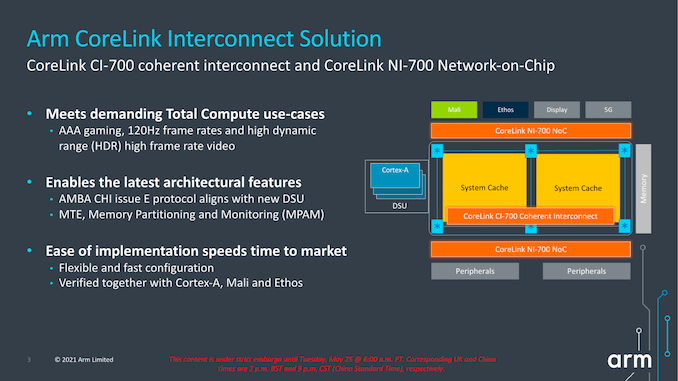

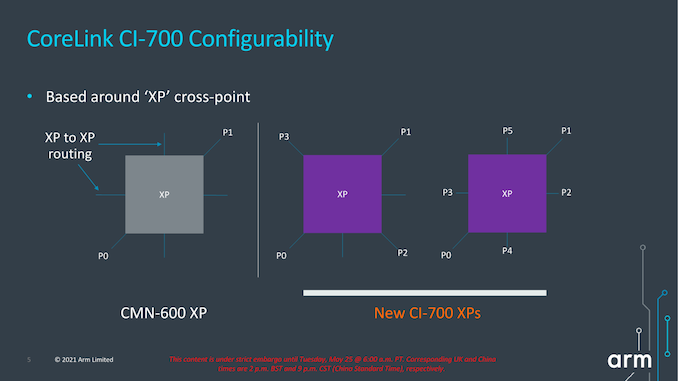
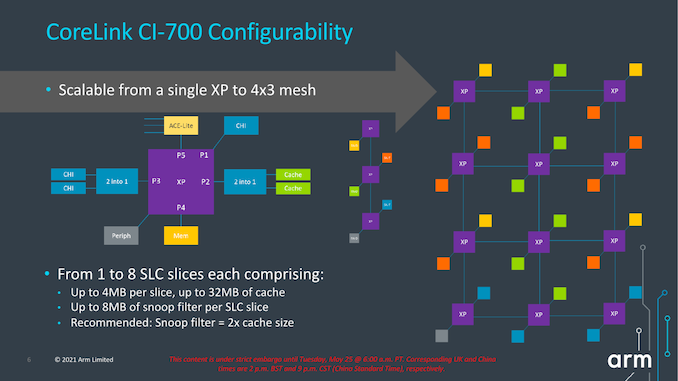
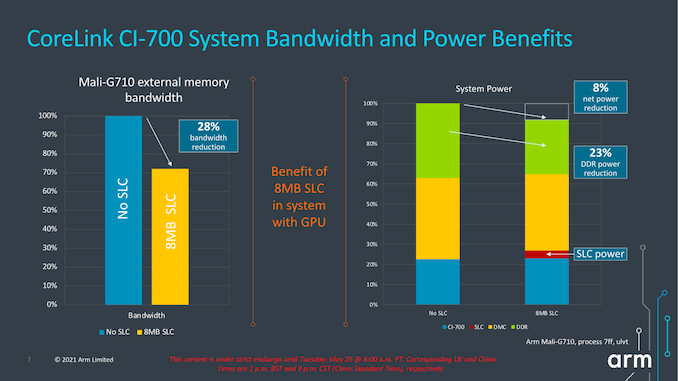
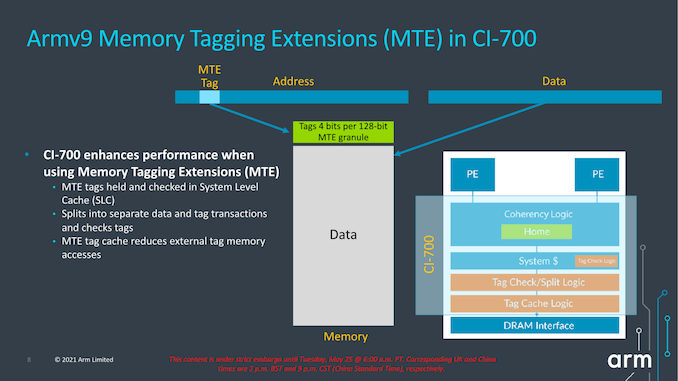









181 Comments
View All Comments
eastcoast_pete - Tuesday, May 25, 2021 - link
Would be great to see QC roll out new, ARM-based but home-made cores again; however, even if they do, the custom designs will most likely be big cores, which get paired with the 510s. But, maybe QC proves me wrong. That would be nice.nandnandnand - Tuesday, May 25, 2021 - link
"Because the new complex also only takes up a single interface on the DSU, it also opens up the possibility of designs larger than 8 “cores”, something I hope won’t happen, or hopefully only happens through more middle or big cores."Nah, I want a 24-core smartphone posthaste.
Kamen Rider Blade - Tuesday, May 25, 2021 - link
There's no point in putting 24-cores in a SmartPhone, other than to drain your battery faster.At the highest end, I think 12-cores in a Top of the line ARM CPU is enough for SmartPhone purposes with this configuration:
2x BIG; 8x Balanced; 2x little cores.
That would be enough for most power users to get everything they need out of their CPU's.
spaceship9876 - Tuesday, May 25, 2021 - link
It would be nice if they released a cortex-A35 successor as that is very old.nandnandnand - Tuesday, May 25, 2021 - link
Plus it could fulfill the efficiency role that A510 apparently fails at.mode_13h - Wednesday, May 26, 2021 - link
If they're going to continue with that product segment, then ARMv9 will virtually force them to.mode_13h - Tuesday, May 25, 2021 - link
Can anyone explain the color splotches in the floorplan plots? What are we supposed to glean from those?vvid - Wednesday, May 26, 2021 - link
>> Can anyone explain the color splotches in the floorplan plots?Each color marks specific unit: ALU, FPU, Instruction Decode, Branch predictor, Load/Store, etc
mode_13h - Thursday, May 27, 2021 - link
Thank you!Kamen Rider Blade - Tuesday, May 25, 2021 - link
So we went from ARM's big.LITTLEI prefer the BIG.little stylization.
to
BIG.Balanced.little as the new paradigm between ARM Core Types.